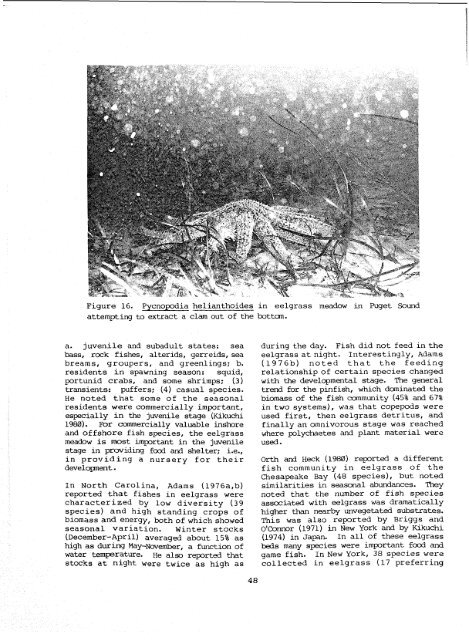The ecology of eelgrass meadows in the Pacific Northwest: A ...
The ecology of eelgrass meadows in the Pacific Northwest: A ...
The ecology of eelgrass meadows in the Pacific Northwest: A ...
- No tags were found...
Create successful ePaper yourself
Turn your PDF publications into a flip-book with our unique Google optimized e-Paper software.
Figure 16. Pycnopodia helianthoides <strong>in</strong> <strong>eelgrass</strong> meadow <strong>in</strong> Puget Sound<br />
attempt<strong>in</strong>g to extract a clam out <strong>of</strong> <strong>the</strong> bottcm.<br />
a. juvenile and subadult states: sea<br />
bass, rock fishes, alterids, yerreids, sea<br />
breams, groupers, and greenl<strong>in</strong>gs; b.<br />
residents <strong>in</strong> spawn<strong>in</strong>g season: squid,<br />
portunid crabs, and some shrimps; (3)<br />
transients: puffers; (4) casual species.<br />
He noted that some <strong>of</strong> <strong>the</strong> seasonal<br />
residents were commercially important,<br />
especially <strong>in</strong> <strong>the</strong> jwenile stage (Kikuchi<br />
1980). For commercially valuable <strong>in</strong>shore<br />
and affshore fish species, <strong>the</strong> <strong>eelgrass</strong><br />
meadow is most important <strong>in</strong> <strong>the</strong> juvenile<br />
stage <strong>in</strong> provid<strong>in</strong>g food and shelter; i.e.,<br />
<strong>in</strong> provid<strong>in</strong>g a nursery for <strong>the</strong>ir<br />
developnent .<br />
In North Carol<strong>in</strong>a, Adams (1976a,b)<br />
reported that fishes <strong>in</strong> <strong>eelgrass</strong> were<br />
characterized by low diversity (39<br />
species) and high stand<strong>in</strong>g crops <strong>of</strong><br />
biomass and energy, both <strong>of</strong> which showed<br />
seasonal variation. W<strong>in</strong>ter stocks<br />
(~ecember-~pril) averaged about 15% as<br />
high as durirng May-~ovember, a function <strong>of</strong><br />
water temperature. He also reported that<br />
stocks at night were twice as high as<br />
dur<strong>in</strong>g <strong>the</strong> day. Fish did not feed <strong>in</strong> <strong>the</strong><br />
<strong>eelgrass</strong> at night. Interest<strong>in</strong>gly, Adalns<br />
(1976b) noted that <strong>the</strong> feed<strong>in</strong>g<br />
relationship <strong>of</strong> certa<strong>in</strong> species changed<br />
with <strong>the</strong> developmental stage. <strong>The</strong> general<br />
trend for <strong>the</strong> p<strong>in</strong>£ ish, which dom<strong>in</strong>ated <strong>the</strong><br />
biomass <strong>of</strong> <strong>the</strong> fish community (45% and 67%<br />
<strong>in</strong> two systems), was that copepods were<br />
used first, <strong>the</strong>n <strong>eelgrass</strong> detritus, and<br />
f<strong>in</strong>ally an omnivorous stage was reached<br />
where plychaetes and plant material were<br />
used.<br />
Orth and Heck (1980) reported a different<br />
fish community <strong>in</strong> <strong>eelgrass</strong> <strong>of</strong> <strong>the</strong><br />
Chesapeake Bay (48 species), but noted<br />
similarlties <strong>in</strong> seasonal abundances. <strong>The</strong>y<br />
noted that <strong>the</strong> number <strong>of</strong> fish species<br />
associated with <strong>eelgrass</strong> was dramatically<br />
higher than nearby unvegetated substrates.<br />
This was also reported by Briggs and<br />
O'Connor (1971) <strong>in</strong> New York and by Kikuchi<br />
(1974) <strong>in</strong> Japan. In all <strong>of</strong> <strong>the</strong>se <strong>eelgrass</strong><br />
beds many species were important food and<br />
game fish. In New York, 38 species were<br />
collected <strong>in</strong> <strong>eelgrass</strong> 117 preferr<strong>in</strong>g

















